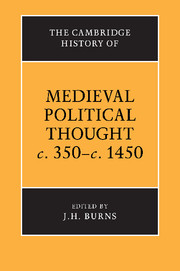Book contents
- Frontmatter
- Introduction
- I Foundations
- II Byzantium
- III Beginnings: c. 350–c. 750
- IV Formation: c. 750–c. 1150
- V Development: c. 1150–c. 1450
- 13 Introduction: politics, institutions and ideas
- 14 Spiritual and temporal powers
- 15 Law
- 16 Government
- 17 Community
- 18 The individual and society
- 19 Property and poverty
- Conclusion
- Biographies
- Bibliography
- Index of names of persons
- Index of subjects
- References
19 - Property and poverty
from V - Development: c. 1150–c. 1450
Published online by Cambridge University Press: 28 March 2008
- Frontmatter
- Introduction
- I Foundations
- II Byzantium
- III Beginnings: c. 350–c. 750
- IV Formation: c. 750–c. 1150
- V Development: c. 1150–c. 1450
- 13 Introduction: politics, institutions and ideas
- 14 Spiritual and temporal powers
- 15 Law
- 16 Government
- 17 Community
- 18 The individual and society
- 19 Property and poverty
- Conclusion
- Biographies
- Bibliography
- Index of names of persons
- Index of subjects
- References
Summary
Between the eleventh century and the fourteenth the economy of Latin Christendom underwent fundamental and rapid transformations. There is, it is true, scholarly debate as to the direction and pace of economic development; but some points are clear enough. The population increased threefold, urban centres attracted an increasingly mobile populace and there was a massive minting of money. At a time when feudal society still flourished, there was a concomitant development of the basic structures of pre-industrial society, most of which had taken shape by 1300, so that many towns were to retain their essential appearance until the nineteenth century. While feudal tenure was still widespread, especially in France, England and the Empire, it appears that in England, by 1300, such tenures were becoming more like private property, transferred by sale as well as, more traditionally, by inheritance. What was formerly seen by historians as the area of ‘classic feudalism’ has shrunk somewhat, for regional studies in France and the Low Countries have shown that even by the mid-eleventh century allodial holdings, independent of vassalage, constituted the principal form of property. Allods meant that real estate was more mobile than an extensively feudalised society would permit. More generally, the commercial revolution of this period produced a market economy centred on towns; and the agriculture which was still the main activity of medieval men and women became organised for that economy. The desire for new land and for the more efficient exploitation of the land led to massive reclamation projects, to the assessment of property by reference to rental income instead of service and produce, and to the increasing importance of bankers and credit transactions.
- Type
- Chapter
- Information
- The Cambridge History of Medieval Political Thought c.350–c.1450 , pp. 607 - 648Publisher: Cambridge University PressPrint publication year: 1988
References
- 19
- Cited by

